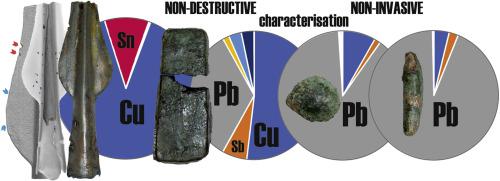Journal of Archaeological Science ( IF 2.6 ) Pub Date : 2021-01-29 , DOI: 10.1016/j.jas.2020.105320 János Gábor Tarbay , Boglárka Maróti , Zoltán Kis , György Káli , László Szentmiklósi

|
The study discusses an unpublished bronze hoard from the famous West Hungarian archaeological site: Velem-Szent Vid (Transdanubia, Vas County). This small Ha B1 assemblage contains a spearhead with remains of the wooden shaft, a sickle, and three different types of ingots. Our aim was a comprehensive structural and compositional characterization of the preserved objects from the hoard exclusively by means of non-invasive and non-destructive analytical, structural, and imaging techniques (XRF, PGAA, TOF-ND, Neutron Imaging, X-ray Imaging). The spearhead and the ingots were studied from production to deposition. Our results suggest that the spearhead was a good quality cast with relatively high Sn content and extremely low porosity rate. It received a minimal post-casting treatment, and hafted similarly to West European Late Bronze Age spearheads. Based on use-wear traces caused by blade-on-blade contact and edge-vs-flat collision, this weapon may have been used in parrying situation. After being used most likely just for a short period, the metal and wooden parts of weapon were intentionally destroyed by plastic deformation prior to deposition. Ingots selected to the Velem-Szent Vid hoard were cast in open one-piece moulds or ‘improvised’ moulds carved to the surfaces or berms of the metallurgical workshop. They have not been partitioned further after casting, but selected for deposition. The elemental composition data of the ingots revealed high quantity of Pb and Sb. The ratio of Pb in the miniature plano-convex ingot (89 ± 0.3 m%) and the rod ingot (94 ± 0.3 m%) was so high that they can be identified as lead ingots, a rare raw material type during the Late Bronze Age. One out of the analysed three ingots, the elemental composition of the cuboid ingot was the most complex, containing high Pb (13–37 m%) and Sb (0.6–6.2 m%) based on PGAA. Chalcocite (Cu2S) was identified by TOF-ND, which points to the possible origin of the raw material or production method (smelting). Our study suggests that this hoard was a combination of a professionally cast spearhead, used and destroyed intentionally along with a fragmented sickle, and three rare and valuable ingots made of specific materials, which were not used after casting. All of them were deposited together in a votive hoard in a central, multi-hoard settlement. Their treatment and selection followed local hoarding traditions practiced in Velem-Szent Vid and its related areas in Transdanubia.
中文翻译:

Velem-Szent Vid山坡上青铜时代晚期Age积的无损分析
该研究讨论了来自西匈牙利著名考古遗址Velem-Szent Vid(瓦斯县Transdanubia)的未出版的青铜ho积。这种Ha B1小型组件包含一个矛头,上面带有木杆,镰刀和三种不同类型的铸锭。我们的目标是通过无创且无损的分析,结构和成像技术(XRF,PGAA,TOF-ND,中子成像,X射线成像)专门对the藏的保存物体进行全面的结构和成分表征)。从生产到沉积研究了矛头和铸锭。我们的结果表明,矛头是高质量的铸件,具有较高的锡含量和极低的孔隙率。它接受了最少的铸造后处理,并且与西欧晚期青铜时代的先头部队类似。根据刀片与刀片之间的接触以及边缘与平坦边缘的碰撞导致的使用磨损痕迹,此武器可能已用于格挡情况。在很可能只是短时间使用后,武器的金属和木质部件在沉积之前被有意的塑性变形破坏。被选为Velem-Szent Vid宝藏的铸锭是在开放的一体式模具或“简易”模具中铸造的,该模具刻在冶金车间的表面或边缘。铸造后,它们尚未进一步分配,但已选择沉积。铸锭的元素组成数据显示出大量的Pb和Sb。微型平凸锭(89±0.3 m%)和棒锭(94±0.3 m%)中的Pb比例如此之高,以至于可以将它们鉴定为铅锭,这是晚期青铜期间的稀有原材料类型年龄。在分析的三个铸锭中,有一个铸锭的元素成分最为复杂,基于PGAA,其铅含量较高(13-37 m%),锑含量较高(0.6-6.2 m%)。绿铅矿(CuTOF-ND确定了2 S),这指出了原料或生产方法(冶炼)的可能来源。我们的研究表明,此ho积是由专业铸造的矛头,故意使用和破坏的镰刀以及三个由特殊材料制成的稀有且有价值的铸锭组合而成的,这些铸锭在铸造后没有使用。所有这些人都一起存放在中央的,多settlement积的定居点中。他们的处理和选择遵循Velem-Szent Vid及其在Transdanubia的相关地区的当地local积传统。











































 京公网安备 11010802027423号
京公网安备 11010802027423号